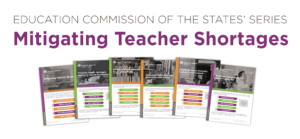 This guest post comes from Alex Hartman, director of teacher pathways at City Year, and Jada Lewis, executive director of City Year Baton Rouge.
This guest post comes from Alex Hartman, director of teacher pathways at City Year, and Jada Lewis, executive director of City Year Baton Rouge.
As schools across the country seek top teaching talent, the struggle to recruit, train and retain teachers remains a daunting challenge. Enrollment in U.S. teacher training programs has plummeted over the past decade, and the decrease in education majors across colleges suggests this trend will continue. The education field faces numerous hurdles, including all-around budget shortages that decrease the ability of states to support, nurture and grow educators; a dearth of teacher diversity; and high teacher turnover, particularly among new teachers and those in high-need public schools.
 As states implement their ESSA plans, there is an opportunity to think creatively about strategies to address teacher shortages. For example, many states, including Arkansas and Tennessee, are using Title II, Part A dollars to support and develop grow-your-own programs that enable districts to develop innovative partnerships to recruit, retain and advance talented, local educators. One potential source for this talent is AmeriCorps, which engages young adults in national service; and policymakers can play a role in establishing and maintaining high-quality pathways into teaching and the broader education sector for these young adults.
As states implement their ESSA plans, there is an opportunity to think creatively about strategies to address teacher shortages. For example, many states, including Arkansas and Tennessee, are using Title II, Part A dollars to support and develop grow-your-own programs that enable districts to develop innovative partnerships to recruit, retain and advance talented, local educators. One potential source for this talent is AmeriCorps, which engages young adults in national service; and policymakers can play a role in establishing and maintaining high-quality pathways into teaching and the broader education sector for these young adults.
Specifically, strategies that provide incentives and remove barriers can be extremely effective, such as giving AmeriCorps alumni priority in state-supported teacher training programs, considering loan forgiveness or hiring bonuses, and re-examining prohibitive and unequitable admission requirements that do not consider the scope of service, career and life experience. States can also encourage districts to leverage Title II of the Higher Education Act to establish partnerships between local education agencies, one or more schools in a district and a partner (such as an institution of higher education) to develop teacher residency programs in high-need schools that have an interest in recruiting and training former AmeriCorps members to serve as teachers.
City Year and its partners are similarly finding ways to address these issues by intentionally strengthening pathways into teaching for the talented young adults who serve as City Year AmeriCorps members in high-need public schools. Each year, City Year recruits and trains 3,000 diverse AmeriCorps members who gain valuable classroom experience during their 10 months as full-time tutors, mentors and role models. More than half are young adults of color; the majority are eligible for Pell grants, an indication of socioeconomic need; and a third are first-generation college graduates.
More than 300 City Year AmeriCorps members decide to become teachers every year. Their City Year experience helps build a deep understanding of the challenges and joys of working in high-need schools, and this translates directly into teacher retention. According to a 2018 City Year alumni survey, 84 percent of alumni who completed City Year three or more years ago and went into teaching currently remain in the classroom.
City Year is supporting these young leaders by building strong, mutually beneficial partnerships with teacher preparation programs that make it easier to enter the profession. City Year serves as one of the largest talent providers for Teach For America and works closely with programs such as Urban Teachers and Relay Graduate School of Education. Local partnerships are also effective — such as in Baton Rouge, where collaboration between City Year, New Schools for Baton Rouge, Relay GSE and other certification programs has produced more than 40 teachers in the last three years.
These strides represent an intentional strategy to capture the strong interest of our AmeriCorps members and alumni in education and to provide multiple pathways into teaching positions. By recognizing and harnessing the experience and dispositions gained in national service programs like City Year, states and districts also have an opportunity to leverage this talent pool to better serve their students and communities.




